51º | Cloudy | 0% chance of rain | Sunrise 6:58 a.m. | Sunset 4:48 p.m.
{{profile.vars.rh_totref_18}} friends are looped into all things local because of you.


– NCCA Home Page
Location: 1001 4th Ave S, Nashville, TN
P.O. Box 150733, Nashville, TN 37215-0733
Support NCCA
Search our site.
© Copyright Nashville City Cemetery 2023 | Website by Atiba
Nashville City Cemetery 20th Annual Living History Tour
Cemetery residents come alive to tell stories and secrets from the “Wild, Wild Western Frontier” of late 18th and early 19th century Nashville.
NASHVILLE, Tenn. -- The Nashville City Cemetery Association (NCCA) invites the community to hear first-hand stories from residents buried in the city’s oldest cemetery as part of its 20th annual Living History Tour on Saturday, Oct. 12 , featuring important figures who fought through daunting challenges to help advance the young city in its earliest days.
This year’s tour, titled “If Tombstones Could Talk: Triumph and Tragedy from the Wild, Wild Western Frontier,” will feature volunteers dressed in full costume, portraying Nashville citizens who faced disease, violence and more as they built Nashville into a leading southern city on the fringe of settled America. Guests can expect to spend about an hour walking with guides through the cemetery to visit each storyteller, with the afternoon tour running from 2-4 p.m. and the night tour––brought back by popular demand––running from 6-8 p.m .
Eighteenth and early nineteenth-century Nashville was the scene of triumph and tragedy on a level difficult to comprehend in modern times. The stories from all walks of life can be shocking and inspiring -- but always educational -- ranging from:
- James and Charlotte Robertson , who endured a treacherous journey including Indian attacks, disease, hunger, and bitter cold, to lead the establishment of Nashville.
- Captain William Driver , who went to sea at 13, was a captain by age 21 and sailed around the world twice before settling in Nashville and later supporting the Union Army in the Civil War.
- Victims of the cholera outbreak of 1833 , which took 174 lives across all demographics, from prominent citizens to penitentiary inmates.
- Alfred Hume , a Nashville native who developed our city’s public school system after visiting Philadelphia, New York, Boston and other eastern cities in the early 1850s to gather best practices.
- Simon the Jockey , brought to America as an enslaved child who became a talented horse racer, beating the formidable Andrew Jackson on several occasions.
- Governor William Carroll , who survived two wars and a notable duel to lead the state and bring the General Jackson, Nashville’s first steamboat, to the Cumberland River.
- Mabel Lewis Imes , who was raised in New England by wealthy relatives, where she took voice lessons and as a result, became a founding Fisk Jubilee Singer and toured the world at the age of just 13.
Fred Zahn, a historic preservationist with the Metropolitan Historic Zoning Commission, has been portraying characters in the Living History Tour for a decade. This year, he will represent Wilkins Tannehill, a former mayor of Nashville, newspaper editor, and grandmaster mason.
“The Living History Tour is a unique chance to make these names, dates, and markers real again, especially for kids,” Zahn said. “It’s incredibly impactful when a visitor realizes that all the folks buried around them had families, jobs, and good and bad days, just like we do today. It’s fun to see people make that tangible connection with the past through the presentation.”
The Tour coincides with the unveiling of the NCCA’s new 28-stop tour app, available for free through the “Tour Buddy” app on Apple and Android devices. This self-guided audio tour leads guests through the cemetery and provides biographies for select residents, as well as pictures and extra information. Visitors can access this tour at any time.
Tickets for the Living History Tour are $5 for individuals, and children 10 and under are free. Attendees are encouraged to purchase them through Eventbrite for a fast entry, but day-of tickets may also be purchased with cash or credit at the front gate at the corner of 4th Ave S. and Oak St. Free parking and shuttle service will be provided by Fort Negley Park at 1100 Fort Negley Blvd. from 1:30-9 p.m.
The Nashville City Cemetery Association is a non-profit whose mission is to protect, preserve, restore, and educate the public about Nashville’s premier outdoor history museum, the Nashville City Cemetery. For more information, visit thenashvillecitycemetery.org .
- Save BIG on Nashville attractions and tours with the Music City Total Access Pass.
- Do more for less with these special offers, discount tickets, package deals, and giveaways.
Get weekly news and exclusive discounts right in your inbox.
Nashville City Cemetery Tour
About this app
Data safety.
App support

Nashville Famous Graves and Cemetery Tour
Nashville area is the final resting place for many famous musicians as well as local prominent people. Grave photos, bio’s and the most helpful GPS location to Nashville’s famous graves. This page highlights many of them but for a more comphrensive website for grave hunting from across the country visit my website famousgravehunter.com .
All the photos are by Tabitha Hawk in Nashville and biographies are from Find a Grave which is an excellent resource for those who are into grave hunting.

For many more famous graves, visit famousgravehunter.com
Hendersonville Memory Gardens
Famous Memorials – Find A Grave at Hendersonville Memory Gardens
( 353 E Main St, Hendersonville, TN 37075) The burial place of Johnny and June Cash, Jean Shepard in Hendersonville, TN.
Notable interments
Max Barnes (1936–2004), songwriter “Mother” Maybelle Carter (1909–1978), musician, songwriter Helen Carter (1927–1998), country singer and daughter of Maybelle Carter Anita Carter (1933–1999), singer-musician and daughter of Maybelle Carter Johnny Cash (1932–2003), country music legend June Carter Cash (1929–2003), country music singer Rosie Nix Adams (1958–2003), singer-songwriter and daughter of June Carter Cash Ferlin Husky (1925–2011), country music singer Merle Kilgore (1934–2005), country music singer-songwriter Joe Maphis (1921–1986), country music master guitarist Johnny Russel Luther Perkins (1928–1968), country music guitarist for Johnny Cash Sheb Wooley (1921–2003), actor and singer-songwriter

Mount Olivet Cemetery in Fall Color
Adelicia Acklen, wealthy Nashville businesswoman and socialite. John Meredith Bass, Mayor of Nashville from 1833 to 1834, and again in 1869.[2] William B. Bate, Governor of Tennessee (1883 to 1887), American Civil War general John Bell, United States Senator and presidential candidate Aaron V. Brown, Governor of Tennessee (1845 to 1847), United States Postmaster General from 1857 to 1859 James Stephens Brown, Mayor of Nashville from 1908 to 1909.[2] George P. Buell, Union Army general Joseph Wellington Byrns, United States Congressman and Speaker of the House John Catron, U.S. Supreme Court Justice Benjamin F. (“Frank”) Cheatham, Confederate general during the American Civil War Mark R. Cockrill (1788-1872), cattleman, planter, and “Wool King of the World”. Clarence Kelley Colley (1869-1956), architect.[3] Washington Bogart Cooper (1802–1888), painter.[4] George A. Dickel (1818–1894), liquor dealer and wholesaler Anne Dallas Dudley (1876–1955), women’s suffrage activist Guilford Dudley, U.S. ambassador to Denmark under the Nixon and Ford presidential administrations, son of Anne Dallas Dudley. Edward H. East (1830–1904), Tennessee Secretary of State, briefly served as the state’s “acting governor” in 1865 Jesse Babcock Ferguson, onetime minister of the Nashville Church of Christ, later associated with Spiritualism and Universalism Thomas Frist, co-founder of Hospital Corporation of America and father of the former majority leader of the U.S. Senate, Bill Frist Francis Furman (1816–1899), Nashville businessman during the Reconstruction Era. A building is named in his honor on the campus of Vanderbilt University, and his tomb, designed by sculptor Johannes Gelert (1852–1923), is the largest one in Mount Olivet Cemetery. Sidney Clarence Garrison (1885-1945), second President of Peabody College (now part of Vanderbilt University) from 1938 to 1945.[5] Meredith Poindexter Gentry, United States Congressman Carl Giers, early photographer Alvan Cullem Gillem, Civil War Union general and post-bellum Indian fighter Vern Gosdin 1934–2009 country music legend William Crane Gray, (1835–1919), First Episcopal Bishop of the Missionary Jurisdiction of Southern Florida Felix Grundy (1775–1840), U.S. Senator from Tennessee and 13th Attorney General of the United States. George Blackmore Guild (1834–1917), Mayor of Nashville from 1891 to 1895.[2] Robert Kennon Hargrove (1829–1905), a Bishop of the Methodist Episcopal Church, South Henry C. Hibbs (1882–1949), architect. E. Bronson Ingram, founder of Ingram Industries Inc., parent company of Ingram Barge Company; Ingram Book Company, the nation’s largest book distributor; Ingram Micro; and other major companies Howell Edmunds Jackson, United States Senator and Supreme Court Justice William Hicks Jackson, Confederate general during the American Civil War Thomas A. Kercheval, Tennessee State Senator and Mayor of Nashville David Lipscomb, founder of Nashville Bible School (now Lipscomb University) William Litterer (1834–1917), Mayor of Nashville from 1890 to 1891.[2] George Maney, Confederate Civil War general and U.S. Ambassador to Chile, Bolivia, Paraguay, and Uruguay Jack C. Massey, entrepreneur who helped found or take public Hospital Corporation of America, Kentucky Fried Chicken and two other NYSE-listed companies Hill McAlister, Governor of Tennessee from 1933 to 1937 Randal William McGavock (1826–1863), Mayor of Nashville from 1858 to 1859 and Confederate Lt. Colonel who was killed in the Battle of Raymond.[2] Eliza Jane McKissack (1828–1900), founding head of music in 1890 to the forerunner of the University of North Texas College of Music Benton McMillin, Governor of Tennessee (1899 to 1903) Kindred Jenkins Morris (1819–1884), Mayor of Nashville from 1869 to 1871.[6] Thomas Owen Morris (1845–1924), Mayor of Nashville from 1906 to 1908.[2] William Nichol (1800–1878), Mayor of Nashville from 1835 to 1837.[2] John Overton, friend of Andrew Jackson and one of the founders of Memphis, Tennessee Bruce Ryburn Payne (1874-1937), founding president of Peabody College (now part of Vanderbilt University) from 1911 to 1937.[7] Colonel Buckner H. Payne (1799-1889), clergyman, publisher, merchant and racist pamphleteer.[8] James E. Rains, American Civil War general killed in the 1862 Battle of Murfreesboro Fred Rose, music publishing executive William Percy Sharpe (1871–1942), Mayor of Nashville from 1922 to 1924.[2] John Hugh Smith (1819–1870), Mayor of Nashville, Tennessee three times, from 1845 to 1846, from 1850 to 1853, and from 1862 to 1865.[2] Ernest Stoneman, country music performer David K. Wilson (1919-2007), businessman and philanthropist; major donor to Vanderbilt University and the Republican Party. Originally known as “The Voice,” Vern Gosdin (1934-2009)

The Main Library's Grand Reading Room (3rd floor) is closed May 1–7 for refurbishment.

Tales From the Crypt: Nashville City Cemetery Edition
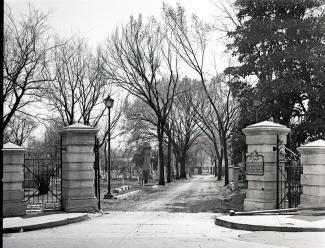
A walk among the tombstones at the Nashville City Cemetery means a walk back through a full-scope of Nashville's past. Most don't realize this significance as they drive down 4th Ave S, but it's been there 200 years now, and will be for 200 more.
The Nashville City Cemetery was not the city's first public burial ground, nor the second, but it has been the permanent one since 1822, making it the oldest public cemetery in the city. And many of the city's former prominent residents rest there now, and collectively tell a variety of narratives about the city's history.
If you're curious about the history of this cemetery, plus want to learn about one of the legends of the grounds, please read on...
Early Nashville Burials: "Bring Out Your Dead!"
When Nashville was just a young pup of a city (only roughly 38 years old), it had already outgrown its physical roots (for burials at least). 1822 was a time in Nashville's past when the city was truly beginning to see its future potential of being more than mostly farmland - it was going to hold its own as an economic and commercial center of the South. That growth meant a physical change in many ways, especially this changing concept of where to bury their deceased.
The Nashville City Cemetery was not the city's first public cemetery, nor their second. While there is no evidence of the first cemetery's location, it is believed to have been located right within the city near the Cumberland River bank and the former public square. The second site was said to be located "...on a hill overlooking the French Lick in the area later known as the Sulphur Spring Bottom." To be a little bit more specific, it was located roughly where the baseball park sits today since it was near the former Sulphur Dell Park, south of Jefferson and between 4th and 5th Aves.
See the 1804 map below with the white arrow indicating approximately where the first burial ground was located.

Little to nothing is left of either site today, but with about 40 years passing before the creation of the Nashville City Cemetery, it is believed there were many graves at both sites.
Carole Bucy and Carol Kaplan explain in their book The Nashville City Cemetery: History Carved in Stone, how Nashville's decision to look for more space for a burial ground went against the norm of the day for cemeteries. Burial grounds were typically within a municipal area or church graveyard, with graves close to each other instead of allowing space for future burials; clearly posterity was not considered.
With the need for much more space and better soil, the city began planning and looking outside its limits.
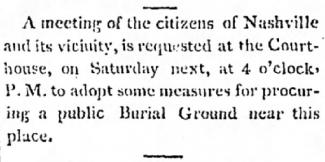
After a public meeting to discuss the matter, four acres of land was purchased from a local tavern keeper and land speculator, Richard Cross for the site of the new cemetery. They purchased the land for $1,200, and the deed specifies...
"...on said four acres to have and to hold the said four acres of land and thirty feet alley to the said Mayor, Alderman and Corporation of Nashville and their successors for the use of a burying ground forever."
From Deed Book O, pg. 9...
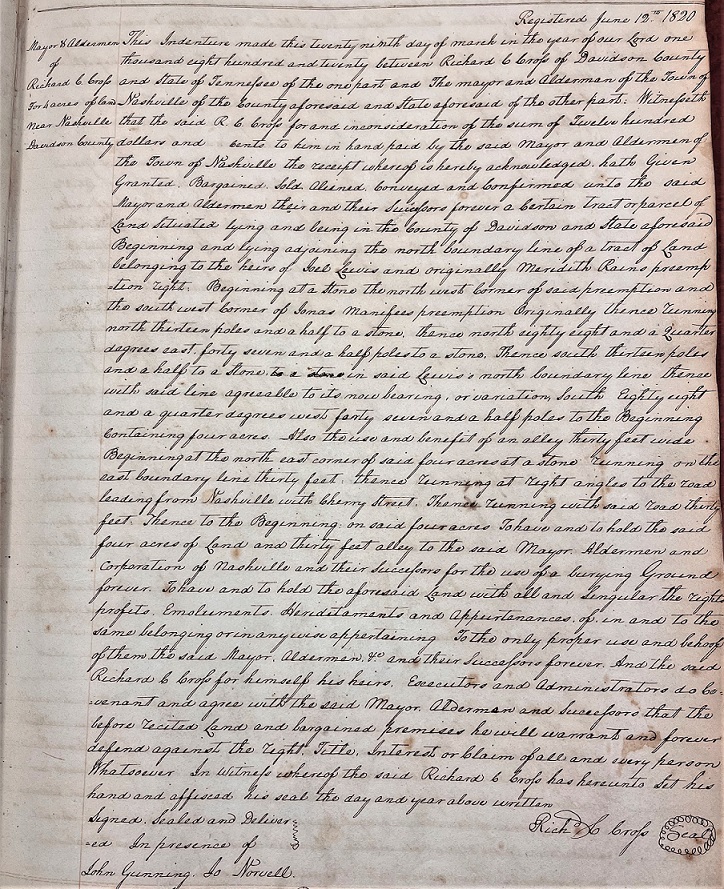
I bet you're wondering 4 acres, that can't be enough! Well it eventually wasn't. Over the cemetery's first 20 years, the city made 8 more land purchases to expand the grounds to its current 27 acres.
The aerial image below from the Walter Williams Collection is from 1936 and shows the cemetery within the yellow box, and the view is facing north.
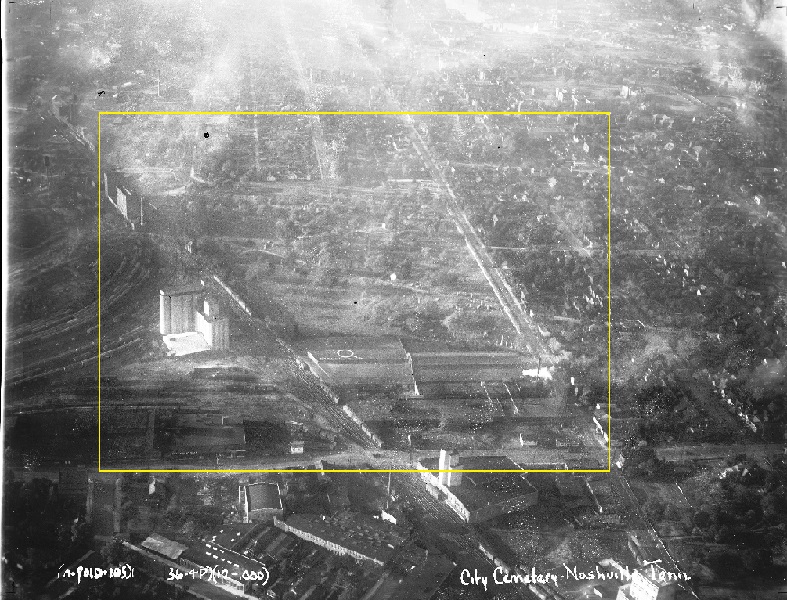
Since this 1822 beginning, there have been roughly 20,000 individuals buried there. Sadly, the records of the earliest burials between 1822 and 1846 were lost during the years of the Civil War. However, over its first few years, burials from other sites such as the Sulphur Spring burial ground and other private places were gradually moved and reinterred at the new cemetery.
Other Facts You Should Know:
- Captain Alpha Kingsley was hired to be the first sexton of the new city cemetery, or essentially the caretaker and gravedigger. It was Kingsley and Louisa Grundy McGavock (daughter of the city's largest landowner Felix Grundy and wife of Jacob McGavock) that created the plans for the new cemetery, which was eventually designed further by Kingsley in the way we know today - with family plots and dividing roads.
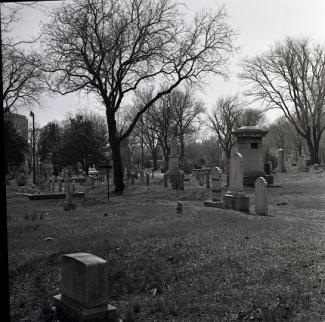
- Lot card for A. Kingsley - Capt. Alpha Kingsley. Unsure of the W.B. Kingsley (not his wife, I don't think). But the E.C. Willson could be his daughter, Eugenia, who passed away in 1841.
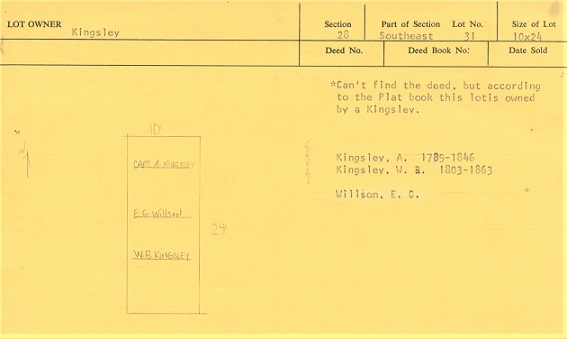
- While the cemetery was maintained by the sale of lots and by other fees, such as for digging graves, in Kingsley's years, there never seemed to be more money earned than spent. And sadly for Capt. Kingsley - his salary was only $400 for his hard work. He'd requested a raise closely before he passed away, but there doesn't appear to be any record whether he received it.
- By 1855, there were more than 11,000 burials in the cemetery. The bulk of those occurring around 1849-50 during the Cholera Epidemic (which occurred several times in Nashville's past). Interments were often listed in the newspapers.

- The area around the cemetery grew more crowded after 1860, when the railroad moved in to the south and several other mills and warehouses as well; the cemetery was no longer on its own out in the countryside.
- With the opening of other cemeteries in the area such as Mt. Olivet (1856), Calvary Cemetery (1868), Mt. Ararat (1869), and several more outside of town - some families of those already interred at the City Cemetery chose to remove their family to these other private locations.
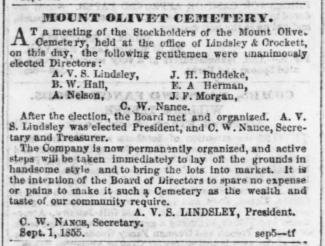
- The location of the cemetery next to Fort Negley was significant considering the impact that had on the grounds; the years during and after the war were tough for the cemetery considering there were a large amount of soldiers' burials that occurred there - for both the Union and Confederacy. The grounds suffered from this and from vandalism that occurred there. However, when the war was over, Union soldiers were removed to the Nashville National Cemetery (est. 1867) on Gallatin Rd. The Confederate burials remained there for a time until a group of Nashville women purchased a large plot at Mt. Olivet and reburied them there in 1869.
- 1878 was a pivotal year for the cemetery. Because of an outbreak of disease in Nashville (Diphtheria) that was believed to have originated from the Cemetery, a vault (housing the infected bodies) was burned down earlier in the year. And, the cemetery was closed to further interments UNLESS it was for already-existing lot owners (which still stands true today). This was an easier alternative to the demand for the cemetery to be permanently closed but thankfully that didn't happen. See the page from the 1878 Board of Alderman minutes, discussing the approval to raze the vault.
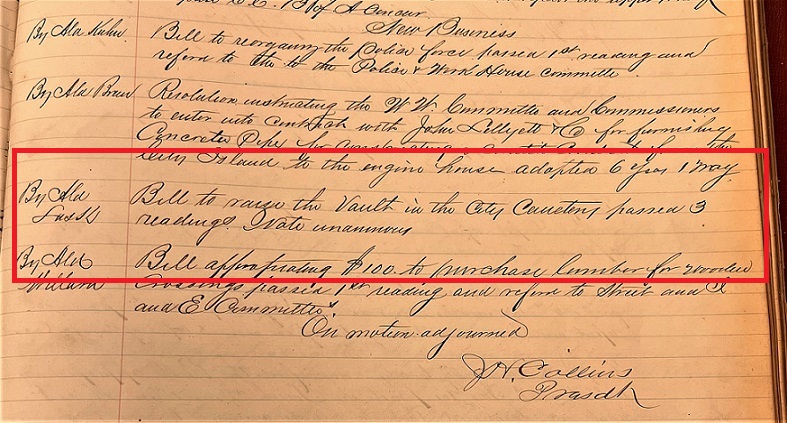
- Over the years, many people attempted to help maintain and restore the aging and deteriorating cemetery, including Mayor West in 1958, who urged the City Council to appropriate $75,000 for the restoration of the cemetery. This helped significantly, adding new water mains and light poles, among other new enhancements.
- In 1972, it was listed on the National Register of Historic Places.
- And lastly in 1998, a group of interested citizens including preservationists and other members of the academic community, plus descendants of those buried there met with staff of both the Metro Historical Commission and Metro Board of Parks, to see what could be done to further restore the cemetery. Out of that came the Nashville City Cemetery Association , that oversees the care of the cemetery today.
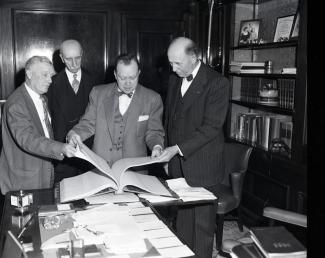

Notable Burials
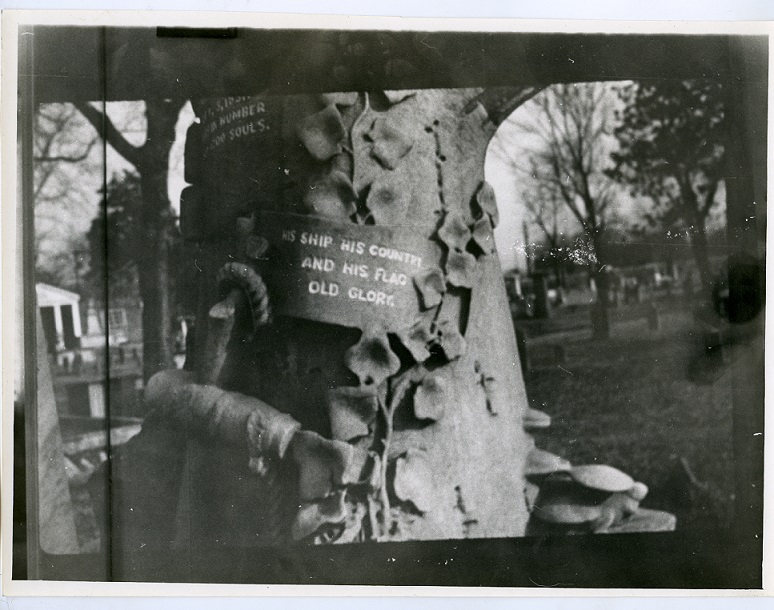
As of today, there are approximately 22,000 people buried at the cemetery, 6,000 of those buried there are African American (the section for the African American graves is separated from the rest and located at the southwestern part of the cemetery). And the rule/law/bill from 1878 that prohibited further burials in the grounds UNLESS you already own a lot still stands - I think. Don't quote me but as far as I can tell - family of those buried there or mayors of the city are able to still be buried there.
Are you curious about who is buried there? Here are a few notable mentions with their date of death in parenthesis...
- Charles Dickinson (1806): Successful in life but sadly listed here because he was shot and killed by Andrew Jackson in a duel.
- Andrew Ewing (1813): Nashville's first clerk of the County Court; signer of the Cumberland Compact.
- James and Charlotte Robertson (1814 and 1843): Two founders of Fort Nashborough; James was another signer of the Cumberland Compact.
- Polly Hill (1847): Mother of former Nashville caterer, Sarah Estell ( click on this link and scroll to the bottom of the blog post to learn more about Sarah Estell's career ).
- It is believed that President James K. Polk (1849) was buried there for a brief time (this man might've traveled more in his death than when he was alive).
- Wilkins Tannehill (1858): Former mayor and business partner of William T. Berry, which is discussed in a previous blog post .
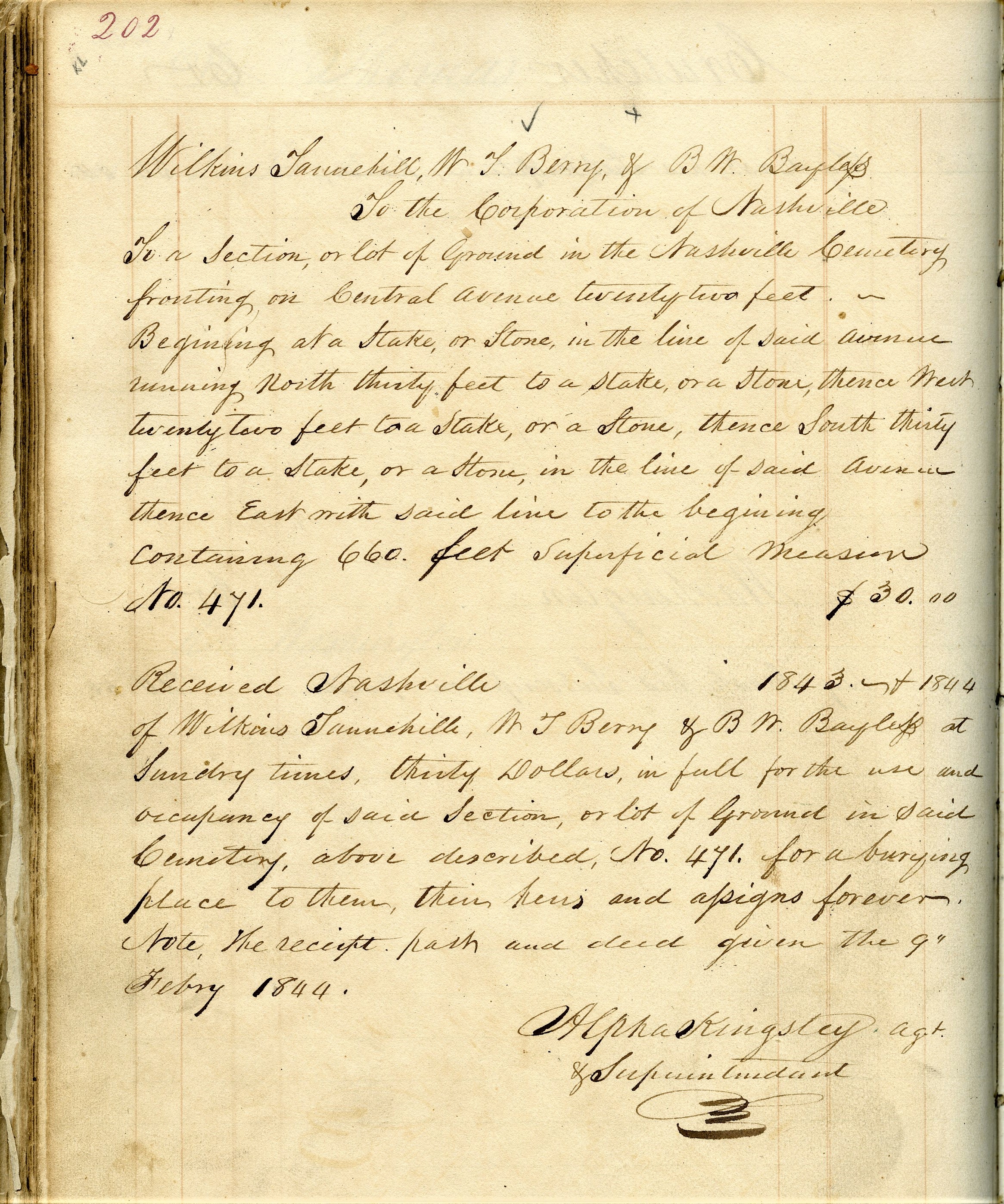
- William Driver (1886): Coined the nickname for the U.S. Flag "Old Glory". See photo above.
- Ella Sheppard (1914) - Famous for her voice and musical talent, and the matriarch of the original Fisk University Jubilee Singers.
- Mabel Imes (1936) - Another member of the original Fisk University Jubilee Singers.
- Harlan Howard (2002) - Country music singer and songwriter.
- 16 (I believe) of Nashville's former mayors are buried in the cemetery ; the most recent one being Mayor Fulton.
Ghost Stories
Now, for what you're reallllyyy here for, right? What else coincides well with cemeteries than ghost stories. Well trust me, with 200 years of existence under its belt, the City Cemetery has some good ghost stories and legends. I'll provide you with one of them...
The Tale of Ann Rawlins Sanders
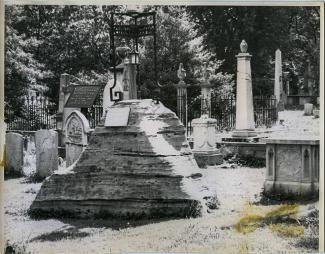
It isn't very often you see a huge rock with a lantern on top as a gravestone in a cemetery, but that is very much the case for the grave of Ann Rawlins Sanders, or so it was rumored for many years.
Poor Ann passed away in 1836 from an apparent suicide of jumping into the Cumberland River after a lover's quarrel. Or so the legend goes.
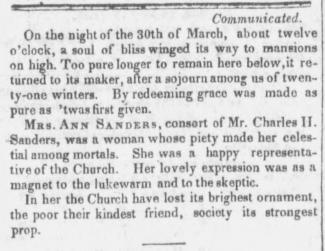
After she was buried, it was said that her fiancé brought a boulder from the river, and a lantern, to the cemetery because Ann was afraid of the dark (not sure being buried 6 feet under a boulder would help that). How romantic yet heart-breaking though.
Over the years, the story has been embellished with people claiming they've seen a woman's ghostly shadow near the grave at night (now I'm embellishing but it could be true).
Here's where I burst your bubble though...none of that is true, including the fact that Ann is not even buried under the boulder. I'm pretty sure she passed away from another affliction as well. Also, she was a married woman and the lantern itself is not from the 1830's, but rather is dated around the early 1900's.
Though what is true is that she is buried on the same lot. The lot where this boulder and lantern reside belongs to Edward Steele (Ann's brother-in-law), and the 1902 sexton, Dan Marlin, said that it is Marion Steele who is actually buried under the boulder. If there's ever a zombie apocalypse with people coming back from the dead, I think it's safe to say she won't be one of them.
For reference if you'd like to visit the cemetery yourself and see this grave, here is the cemetery plat and section 18 is the location of the Steeles' lot (coming from the Oak St. entrance, this grave is easy to spot)...
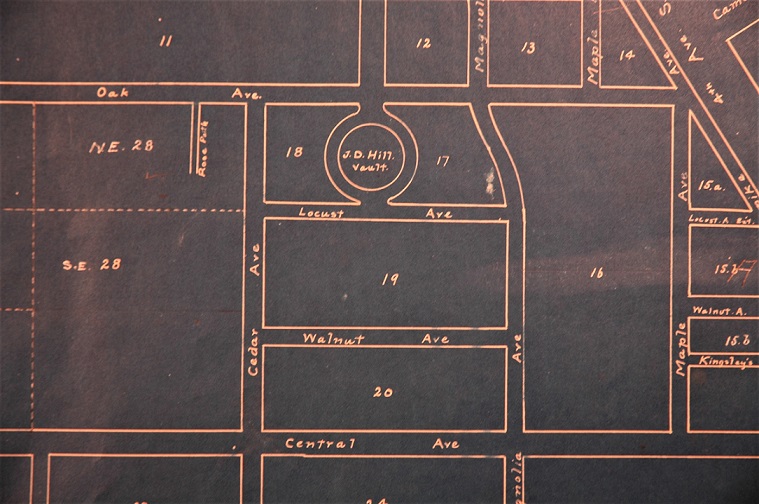
If you're interested in learning more about the cemetery, I will provide you with three recommendations...
- Check out the book below that I used for research: The Nashville City Cemetery: History Carved in Stone.
- Check out the City Cemetery Association's website , and better yet - go on a tour of the grounds. They provide information for a self-guided tour. Or you can schedule a group tour.
- Lastly, when the cemetery discontinued keeping the cemetery's records within the office on site, they moved their records to the our collections in Archives. We have plats, deeds, lot cards (as I provided example of above), and photos of the cemetery. So we're glad to assist you in your research.
And this post was supposed to be finished by the end of January, so stay tuned for another post later this month.
'Til next time,
The Nashville City Cemetery: History Carved in Stone
- More Like This
- Add to List
Sarah is a Program Coordinator with Metro Archives. Her interests and areas of expertise are history, reading books (of any kind), music, travel, Harry Potter, and bingeing a good comedy series . When not in Archives, she is either nose-deep in a book or planning her next trip. Learn more about the fascinating materials found at Metro Archives through their website .
- Nashville / Community History
Genre / Topics
- Community Life
- Downtown Nashville
- Early Nashville
- Fairy Tales, Folk Tales, and Myths

The Tennessee Tribune
Insightful coverage of Nashville and Middle, TN news
Nashville City Cemetery Holds Living History Tour
Haunted Nashville City Cemetery
Nashville city cemetery.
Nashville City Cemetery is Tennesee’s oldest burying ground, established well before the Mexican-American war. Tennessee is chock full of great barbecue, history, country music, and a heap of lesser-known haunted locations. The Volunteer State was originally part of North Carolina before it was admitted to the Union on June 1st, 1796, as the 16th U.S. state. The state earned its nickname during the War of 1812 when many Tennesseans would step in to assist in any way they could with the war effort. The nickname became even more prevalent when during the Mexican-American War in 1846. The Secretary of War asked the state to provide the effort with 2,800 soldiers, and Tennessee sent over 30,000. A true southern gem, Tennessee lives up to its name. What about hauntings, though? Most residents know of the paranormal happenings at Tennessee State Prison, Ryman Auditorium, and even Opryland Resort, but below is one of many of Tennessee’s lesser-known hauntings: Nashville City Cemetery.
Nashville City Cemetery’s History
Nashville City Cemetery is the oldest public burial ground in the city of Nashville. This Music City cemetery is the site of over 22,000 burials, many of which include famous historical figures such as Charles Dickinson and musicians. A serene and beautiful memorial to Tennessee’s deceased, the cemetery truly comes alive with ghostly phenomena at night.
Constructed in 1822 by William Strickland, the cemetery has been the top choice for local notables’ last resting place since its inception. One may recognize the name William Strickland, as this New Jersey architect had a penchant for Greek Revival architecture, and he designed multiple buildings in Tennessee as well as Pennsylvania, including the Tennessee State Capitol Building and the Belmont Mansion. The grounds were designed with plenty of pathways and greenery, reminiscent of a park. By 1850, the cemetery was halfway to its capacity, with over 11,000 bodies interred here. However, the regular burials couldn’t stop the area from falling into disarray, and the cemetery decayed until the late 1950s. Ben West, the mayor of Nashville in the 1950s, came forward with ideas to preserve the historic cemetery. Ten years later, it was added to the National Register of Historic Places. Among the many people buried here lie Nashville’s founders, James, and Charlotte Robinson, as well as Confederate Army generals and influential politicians and their families. One of the most significant features of the cemetery is the fact that the area was not segregated, despite being centuries old. With most cemeteries in the south separating the dead by their race, Nashville City Cemetery buried people from all walks of life together so that they could rest in harmony. In recent years, the city has made an effort to highlight and acknowledge the enslaved people buried here in the graveyard by replacing their small headstones with significant and beautiful memorials. Wander around the grounds of this cemetery, and you’ll find all walks of life from soldiers to blacksmiths, civic leaders to confederate generals, as well as slaves and carpenters.
While the cemetery itself isn’t home to many disturbing tales, one location in particular within has given this cemetery its haunted reputation: Ann Rawlins Sanders and ‘Suicide Rock.’ This unique attraction brings about plenty of visitors to learn of the ghost story attached to it.
Within the cemetery lies a large boulder-like headstone that sits towards the front of the cemetery. It marks the final resting place of a woman named Ann Rawlins Sanders, who died in 1836. Ann died young at just 21 years of age, leaving behind her husband of four years, Charles. The story goes that the night of Ann’s death, she and Charles had a massive argument. The confrontation became extremely heated, and Ann ran away from her home and problems, but since she had nowhere to escape to, she ended up just wandering around town trying to plan her next move. Eventually, she found herself on a cliff that towered above the Cumberland River. In a moment of exhaustion and sadness, she jumped, plunging into the river below and drowning. Lost in her loneliness, she didn’t realize that her husband had followed her, searching for her in the darkness. He found out what had happened the following day, and for her burial, he had a piece of the cliff cut and placed atop her grave. Ann was notoriously afraid of the dark, and so her husband also had a lantern installed above her grave to provide her spirit with plenty of light.
At Ann’s grave, people report the sounds of sobbing and arguing despite no one being around. Witnesses have also seen a woman sitting atop the boulder with her face in her hands, disappearing as soon as they come too close. The headstone itself, made from the cliffside Ann leaped from, has a dark and gloomy history attached to it, making it a meeting place for other spirits in the cemetery, including a man dressed in old-fashioned clothing who has been seen sitting with Ann near the boulder and has even been witnessed lighting the lantern for Ann.
Other Resident Spirits and Popular Gravesites
Many of Nashville’s most famous are buried at Nashville City Cemetery. It’s no wonder the cemetery is almost as old as the city itself! Included in the mix is renowned duelist and attorney Charles Dickinson. He was initially laid to rest in his family’s plantation’s land but was reinterred for safekeeping in the Nashville City Cemetery in 2010 when his grave was discovered. Dickinson has bled to death after a duel with Andrew Jackson, who went on to become president of the United States. It is said that Charles Dickinson shot to kill and aimed for Jackson’s chest. Jackson fought the same way, and apparently, his gun skills were a bit sharper and faster as he won the duel. Andrew Jackson’s reputation suffered due to this, but he still moved forward in his political endeavors.
Another of Nashville City Cemetery’s most notable is the gravesite of Salem-native William Driver. Born in Massachusetts in 1806, William Driver was a sea captain who began his long maritime career as a cabin boy years prior. After he was appointed and recognized as a master mariner, his mother sewed him a flag to fly upon his own ship, a symbol he named ‘Old Glory.’ Little did he know, but that flag eventually became the United States flag. When Union soldiers occupied Nashville in 1862, Old Glory was placed atop the Tennessee State Capitol building, and the rest just fell into place in history.
Captain William Driver’s ornate and gorgeous grave marker was made in the shape of a tree branch with a large anchor to represent his life at sea and his love for sailing. It also includes three different epitaphs that recount his travels and the history of ‘Old Glory.’ Four Confederate generals also lie buried within the cemetery grounds, alongside multiple Nashville mayors, including Francis Fogg (Who developed Nashville’s public school system) and a handful of senators.
Visitors to the gravesite of Charles Dickinson report cold chills and goosebumps on warm days if they sit down near his headstone, as well as the feeling of being watched very closely and taps on the shoulder when no one else is around.
Have you ever visited the Nashville City Cemetery? What was your experience like there? Visiting the oldest cemetery in Tennessee must come with some pretty otherworldly experiences, and the reports and sightings that have come out of this famous burial ground prove that! If you’d like to learn about more haunted Nashville locations, stick around throughout the month of April for more articles and check out our post for the Haunted Wheatlands Plantation !
Sources Cited:
https://en.wikipedia.org/wiki/History_of_Tennessee
https://www.budgettravel.com/article/five-haunted-places-in-tennessee
https://www.youtube.com/watch?v=nSGeCsgN31M
https://en.wikipedia.org/wiki/Nashville_City_Cemetery
https://www.onlyinyourstate.com/tennessee/nashville/nashville-city-cemetery-history/
- Demonstration & Educational Gardens at Ellington Agricultural Center
- Harding Gardens at Belle Meade
- Heirloom Garden at TN Agricultural Museum
- Kitchen Gardens at Andrew Jackson's Hermitage
- Nashville City Cemetery
- Speakers Bureau
- The Nashville Fair
- UT Extension Arboretum at Ellington
- Need Help? Ask A Master Gardener
- Gardening Resources
- Newsletter Archive
Walking Tour of Historic Nashville City Cemetery
- When May 14, 2022
- 10:00 AM - 11:30 AM
- Location Nashville City Cemetery - 1001 Fourth Avenue South, at the corner of Fourth Avenue South and Oak Street
The Master Gardeners of Davidson County celebrate the 200th Birthday of our Historic Nashville City Cemetery with a free walking tour led by fellow MG Catherine Atwell.
We will explore the Civil War Medicinal Bed along with the gardens we support surrounding the Keeble Building containing native plants, the significance of the landscape plants and different grave types where rest some of Nashville’s early settlers.
This tour is free and open to the public and begins at the Keeble Building.
Email Amanda Irwin, Cemetery Project Lead, [email protected] with any questions.
©2023 Master Gardeners of Davidson County All Rights Reserved. NOTICE: Trade and brand names are used only for information. Tennessee Extension does not guarantee nor warrant the standard of any product mentioned; neither does it imply approval of any product to the exclusion of others which also may be suitable. Programs in agriculture and natural resources, 4-H youth development, family and consumer sciences, and resource development. University of Tennessee Institute of Agriculture, U.S. Department of Agriculture and county governments cooperating. Tennessee Extension provides equal opportunities in programs and employment.
Nashville City Cemetery Tour 17+
Nashville's history museum, the nashville city cemetery association, inc., designed for ipad, screenshots, description.
The Nashville City Cemetery Association, Inc. is a membership organization that works to protect, preserve, restore and raise public awareness of the Nashville City Cemetery in collaboration with the Historical Commission of the Metropolitan Government of Nashville and Davidson County, Tennessee. Eighteenth and early nineteenth century Nashville was the scene of triumph and tragedy on a level difficult to comprehend in modern times. The stories from all walks of life can be shocking and inspiring, but always educational. This self guided audio tour leads guests through the cemetery and provides biographies for select residents, as well as pictures and extra information. Visitors can access this tour at any time. Please note: Continued use of GPS running in the background can dramatically decrease battery life.
Version 9.0.115
Minor Bug Fixes and Improvement
App Privacy
The developer, The Nashville City Cemetery Association, Inc. , indicated that the app’s privacy practices may include handling of data as described below. For more information, see the developer’s privacy policy .
Data Not Linked to You
The following data may be collected but it is not linked to your identity:
- Diagnostics
Privacy practices may vary based on, for example, the features you use or your age. Learn More
Information
- Developer Website
- App Support
- Privacy Policy
You Might Also Like
Rodin Museum Full Edition
Sylvester Manor Walking Tour
Downtown LaBelle
Nashville Top Five
Memphis Tours
Visit Columbia TN
- Share full article
Advertisement
Supported by
ACROSS THE COUNTRY

Showcase for Antebellum Homes Displays Their Finery. But What About the History?
Each spring, Columbus, Miss., has opened its Civil War-era homes to visitors. Some say the event should reflect more the oppression behind the architecture, and how the city has changed since.
WHY WE’RE HERE
We’re exploring how America defines itself one place at a time. In Mississippi, a tradition of house tours is about more than architecture. It’s a window into how a city sees its past and its ambitions for the future.
By Rick Rojas
Photographs by Kate Medley
Reporting from Columbus, Miss.
Women in hoop dresses ushered visitors one April morning into the grand old house known as Riverview, showing off the hand-carved wooden chairs, oil paintings, tapestries and gilded mirrors brought from around the world to the estate in Mississippi.
The house stood as a testament to the prosperity that had flowed before the Civil War in Southern cities like Columbus, just over the border from Alabama, as fertile soil and the labor of enslaved workers built fortunes.
It was also a highlight of the longstanding tradition known as Pilgrimage. Every spring, the city’s finest antebellum homes are opened to the public for a few weeks, inviting people in to marvel at the craftsmanship and the opulence.
The event took its name from the belief among its organizers that Pilgrimage was just that — a journey to houses whose grandeur, scale and history represent something sacred for Mississippi and all of the South. Homeowners and docents often dress in period clothing to facilitate the time travel.
“We have a culture here that is something to be admired and respected,” said Dick Leike, the owner of Riverview. “This is a prime example of it.”
But these days, some in Columbus are finding it difficult to justify a trip to a gauzy version of the city’s past without accounting for the suffering, injustice and violence associated with the slave labor that built and ran these homes. That has led to competing ideas about the scope of Pilgrimage and the story it is supposed to tell.
A theatrical production staged by a local high school every year during the weekslong event now depicts the plights of enslaved African Americans and 19th-century immigrants who lived in Columbus. The local synagogue has been added to a church tour. Other events feature the region’s Choctaw and Chickasaw history.
“It seems like Pilgrimage only told one story, and that traditionally attracted a certain demographic — an older demographic, a more white demographic,” said Jace Ferraez, a 34-year-old lawyer who left Columbus after growing up there, moved back and is buying a historic home with his fiancé.
He and other like-minded residents, he said, “want to tell a fuller story.” The aim is to relay history with more breadth, but also showcase the city as it is now, encompassing its struggles, strengths and sense of possibility.
No interstate runs through Columbus, whose population of 23,000 is roughly one-third white and two-thirds Black. Poverty has been a persistent issue, as has persuading young people to choose to stay in Columbus.
Still, parts of the city are lively. Friendly City Books, an independent bookseller, opened downtown a few years ago and became a haven for its regulars. An arts center up the block displays the works of local artists like Ralph Null, a celebrated floral designer turned painter. Newcomers can easily get recruited to a perpetual circuit of cocktail gatherings.
“There’s a lot of things that can divide a community — economic status, race, the list goes on,” Mr. Ferraez said. But, he added, Pilgrimage could be more inclusive and reflect Columbus’s diversity and its aspirations. “It helps bring people together.”
The diverging ideas about Pilgrimage are just another variation of a familiar tension in the Deep South, where the past so rarely stays in the past. For some, the enduring consequences of systemic oppression are what keep them in history’s grip. For others, it is an abiding desire to hold onto what they consider a glorious legacy.
Four years ago, Mississippi abandoned the state flag that flew for 126 years with a Confederate battle emblem embedded in it, and the Confederate monument that had been perched for a century on the lawn of the Lowndes County Courthouse in Columbus was moved to a secluded cemetery in 2021.
But this month, Gov. Tate Reeves signed a proclamation designating April as Confederate Heritage Month, as he and his predecessors have done almost every year since 1993 . Many residents of the state still insist that reasons other than slavery drove the Civil War.
As Mr. Leike pointed out marble flooring on the porch, ornate molding in the parlors and stained glass made by Italian artists, he said that outsiders clung to stereotypes of the South as impoverished — financially, culturally and intellectually.
That was why he opened up Riverview for Pilgrimage. The house was an irrefutable rebuttal.
“You want the people to know we’re not just down here in shanties,” said Mr. Leike, a prominent figure in the real estate industry in the region.
The fact that Columbus still has scores of antebellum homes is a direct result of history. Few Southern cities can count that many, as most of theirs were destroyed in the war. But many in Columbus had been spared because the city was a hospital town treating Confederate and Union soldiers, residents said.
Pilgrimage began in Columbus around 1940 as a way to display and safeguard these homes. Over the years, the event has drawn tourists to Columbus and ticket sales have supported nonprofits behind the programs. The city, like others with their own take on Pilgrimage, followed Natchez, a city on the Mississippi River with an even larger roster of houses .
Tell Us About Where You Live
On a recent morning, Joe Beckett, a contractor who specializes in renovating antebellum homes, walked visitors through one that he worked on called Snowdoun, built in 1854.
He pointed out that Jefferson Davis had once delivered a speech from the front balcony — just one of the many prominent figures who had passed through, he said.
His face lit up, though, as he explained the surprises and challenges that he stumbled across in his work: the intricate setup of wooden pieces engineered to undergird a curved staircase, the painstaking process of mixing 19th-century compounds by hand to match an original paint color or the lamp that he was converting back to being powered by gas.
“Pretty cool, pretty cool,” Mr. Beckett said.
He wanted to share that passion with others.
No one involved in Pilgrimage had any interest in papering over the sins of slavery, he said, or overlooking the contributions of enslaved people, either.
“We don’t get into a lot of the detail,” Mr. Beckett said, referring to mentions of slavery during Pilgrimage. “But we do recognize their input, their value and the services they provided to build these homes, to build our culture.”
Still, some of those trying to maintain the tradition are attempting a delicate balance, celebrating the houses — their splendor, their sophistication — without explicitly examining the injustices they also represent.
An impossible balance, others argue.
“The problem is that it is also a celebration and endorsement of slaveholding,” said Chuck Yarborough, a history teacher at the Mississippi School for Mathematics and Science, a public boarding school in Columbus that draws high-achieving students from across the state.
The answer, in his mind, is not selectively ignoring parts of the past. Instead, Mr. Yarborough said, Pilgrimage is an opportunity to lay it all out, recognizing “the completeness and the complexity.”
“I think it’s important for a community to have an honest view of itself,” he said.
“Tales From the Crypt,” a performance staged in a cemetery by students at Mr. Yarborough’s school for more than 30 years, is trying to do just that.
Mr. Yarborough’s students use historical documents, like newspaper articles or immigration records, to write and perform vignettes that flesh out people from the past, and shade in the context of the world they inhabited.
As dusk faded into night during one performance, the audience was guided from one torch-lit scene to another.
One student, Antanae Shelton, portrayed a free woman of color who explained how her status was a misnomer; her freedom was saddled with so many restrictions it was not really freedom at all.
Drew Dowdy played a Greek immigrant named Victor Corfeates who opened a confectionary in Columbus and, according to Mr. Dowdy, sought and found acceptance from his neighbors. “Sweetness ignores the borders between men,” he said.
The specter of a woman who lived in the late 19th and early 20th centuries named Frances Saunders Billups Westmoreland embodied the city’s dilemma in determining how to regard its past, according to Brooke Anderson’s interpretation.
Ms. Westmoreland’s family had been a powerful one. She had grown up in one of those grand estates. Her grandfather had enslaved more than 200 people.
Once, those details had been markers of status and success. But pride had curdled into shame. Ms. Westmoreland, as channeled by Ms. Anderson, confessed that she had “overlooked the suffering and hardship my family contributed to.”
“I suppose I have an eternity to think about that,” the ghost said as she retreated into the darkness, her face buried in her hands.
Rick Rojas is the Atlanta bureau chief for The Times, leading coverage of the South. More about Rick Rojas
Across the Country
We’re exploring how america defines itself one place at a time..
Columbus, Miss.: Each spring, this Southern city has opened its Civil War-era homes to visitors. But some say the event should instead reflect the oppression behind the architecture .
Alta, Utah: As a throwback destination, the cult-favorite ski town thinks small, with a one-room public school to match .
Georgia: Augusta National Golf Club has long forbidden cellphones for almost anyone at its hallowed tournament, the Masters, but patrons delight in making free calls the old-school way via landlines.
Maine: In a rural area where a small Jewish population often needs grit, ingenuity and strong relationships to achieve its goals, a liberal arts college and a synagogue have long been closely tied .
Beaufort, N.C.: The Bodacious Belles, a locally famous group of rambunctious retirees, shows the difference a network of support can make in an aging America .

COMMENTS
The Nashville City Cemetery provides free tours on the second Saturday of each month. These themed tours cover various aspects of the history of the people buried here and of the the cemetery's story. In addition, the month of October is our traditional tour month, with options over the years ranging from living history tours with costumed ...
The Nashville City Cemetery, located at 1001 4th Avenue South, is the oldest continuously operated public cemetery in Nashville. On March 9, 1820, the mayor and aldermen of Nashville purchased four acres of land located "on the plains, south of town, for its burying ground.". The cemetery opened on January 1, 1822.
The Nashville City Cemetery, located on 4th Avenue South and Oak Street (1001 Fourth Avenue South), was begun in the 1820s, ... Things To Know Before Going to the Nashville City Cemetery. All tours must be booked through the Metropolitan Historical Commission, 615-862-7970. This is an active cemetery with funerals.
This tour is offered by the Nashville City Cemetery Association. The Nashville City Cemetery Association, Inc. is a membership organization that works to protect, preserve, restore and raise public awareness of the Nashville City Cemetery in collaboration with the Historical Commission of the Metropolitan Government of Nashville and Davidson ...
The four-acre cemetery opened on January 1, 1822 and had expanded to 27 acres by 1856. Nashville City Cemetery was listed in the National Register of Historic Places in 1972. ... Download the Nashville City Cemetery Tour app for a self-guided experience with 29 featured stops outlined with directions, historical information, and audio.
A virtual tour of the Nashville City Cemetery for the Metropolitan Government of Nashville and Davidson County
The cemetery is open for public visitation daily from dawn to dusk. Download the Nashville City Cemetery Tour app for a self-guided experience with 29 featured stops outlined with directions, historical information, and audio. You can also access cemetery records + utilize available maps and this arboretum guide to plot your own route.
The Nashville City Cemetery Association web site provides information, news and announcements for people interested in supporting Middle Tennessee's oldest city cemetery. ... NCCA is involved with sponsoring special tours open and free to the public, including the Annual Living History Tour, and in developing the NCCA web site to make available ...
NASHVILLE, Tenn. -- The Nashville City Cemetery Association (NCCA) invites the community to hear first-hand stories from residents buried in the city's oldest cemetery as part of its 20th annual Living History Tour on Saturday, Oct. 12, featuring important figures who fought through daunting challenges to help advance the young city in its earliest days.
The Nashville City Cemetery Association, Inc. is a membership organization that works to protect, preserve, restore and raise public awareness of the Nashville City Cemetery in collaboration with the Historical Commission of the Metropolitan Government of Nashville and Davidson County, Tennessee.
Spring Hill Cemetery. Famous Memorials - Find A Grave at Spring Hill Cemetery. (5110 Gallatin Pike S, Nashville, TN 37216) The history of Spring Hill dates back to the 1780s when the first settlers moved in from the Cumberland settlement into an area six miles east of Nashville called Haysboro.
The Ghosts of the Nashville City Cemetery. Nashville City Cemetery is the oldest public cemetery in Nashville, Tennessee. Home to many historical figures and musicians, this Music City burying ground houses over 22,000 burials. A calm historic site by day, buzzing with spirits by night, the Old City Cemetery (as it's often called) has been ...
View of the Oak St. entrance to the Nashville City Cemetery. ... They provide information for a self-guided tour. Or you can schedule a group tour. Lastly, when the cemetery discontinued keeping the cemetery's records within the office on site, they moved their records to the our collections in Archives. We have plats, deeds, lot cards (as I ...
Download Nashville City Cemetery Tour and enjoy it on your iPhone, iPad, and iPod touch. The Nashville City Cemetery Association, Inc. is a membership organization that works to protect, preserve, restore and raise public awareness of the Nashville City Cemetery in collaboration with the Historical Commission of the Metropolitan Government ...
Cemetery Residents Come Alive to Tell Stories and Secrets from the "Wild, Wild Western Frontier" of the late 18th and early 19th Century Nashville.. NASHVILLE, TN — The Nashville City Cemetery Association (NCCA) invites the community to hear first-hand stories from residents buried in the city's oldest cemetery as part of its 20th annual Living History Tour on Saturday, Oct. 12 ...
Nashville City Cemetery is the oldest public burial ground in the city of Nashville. This Music City cemetery is the site of over 22,000 burials, many of which include famous historical figures such as Charles Dickinson and musicians. A serene and beautiful memorial to Tennessee's deceased, the cemetery truly comes alive with ghostly ...
Walking Tour of Historic Nashville City Cemetery When. May 14, 2022 . 10:00 AM - 11:30 AM. Location. ... The Master Gardeners of Davidson County celebrate the 200th Birthday of our Historic Nashville City Cemetery with a free walking tour led by fellow MG Catherine Atwell.
Download Nashville City Cemetery Tour and enjoy it on your iPhone, iPad and iPod touch. The Nashville City Cemetery Association, Inc. is a membership organization that works to protect, preserve, restore and raise public awareness of the Nashville City Cemetery in collaboration with the Historical Commission of the Metropolitan Government of ...
Each spring, Columbus, Miss., has opened its Civil War-era homes to visitors. Some say the event should reflect more the oppression behind the architecture, and how the city has changed since.